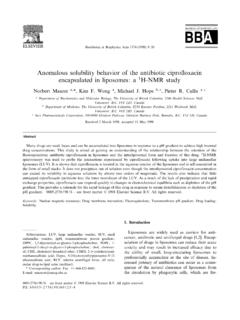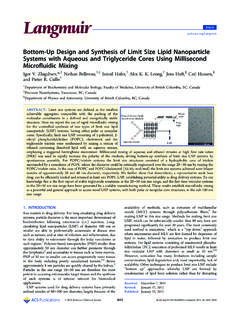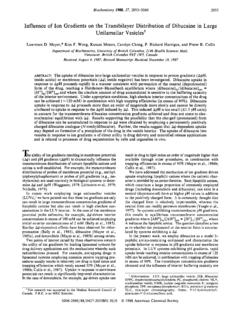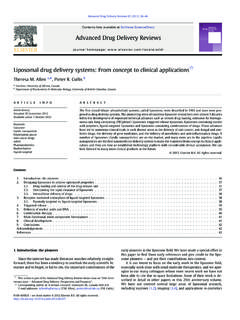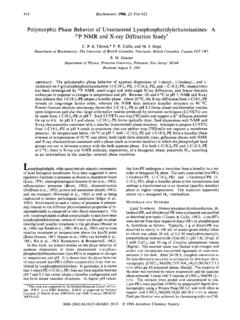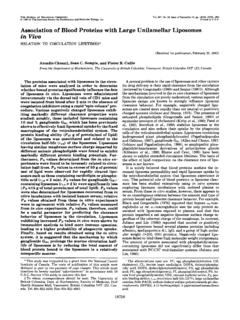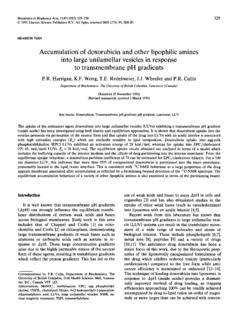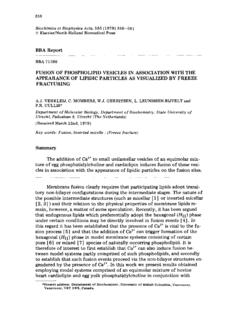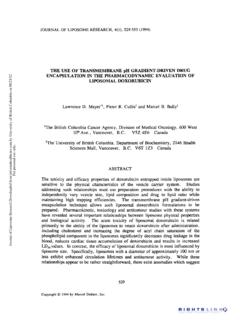Transcription of Lipid nanoparticle delivery systems for siRNA …
1 REVIEW ARTICLEL ipid nanoparticle delivery systemsfor siRNA -based therapeuticsC. Wan&T. M. Allen&P. R. Cullis#Controlled Release Society 2013 AbstractTherapeutics based on small interfering RNA( siRNA ) have a huge potential for the treatment of diseasebut requires sophisticated delivery systems for in vivo appli-cations. Lipid nanoparticles (LNP) are proven delivery sys-tems for conventional small molecule drugs with over eightapproved LNP drugs. Experience gained in the clinical de-velopment of LNP for the delivery of small molecules,combined with an understanding of the physical propertiesof lipids , can be applied to design LNP systems for in vivodelivery of siRNA . In particular, cationic lipids are requiredto achieve efficient encapsulation of oligonucleotides; how-ever, the presence of a charge on LNP systems can result intoxic side effects and rapid clearance from the circulation. Toaddress these problems, we have developed ionizable cat-ionic lipids with pKa values below 7 that allow oligonucle-otide encapsulation at low pH ( , pH 4) and a relativelyneutral surface at physiological pH.
2 Further optimization ofcationic lipids to achieve maximized endosomal destabiliza-tion following uptake has resulted in LNP siRNA systemsthat can silence genes in hepatocytes at doses as low mg siRNA /kg body weight in mouse models. Thesesystems have been shown to be highly effective clinically,with promising results for the treatment of hypercholesterol-emia and transthyretin-induced amyloidosis among LNP siRNA therapeutics, targeting different tissuesand diseases, are expected to become available in the delivery siRNAsystemsIntroductionRNA interference (RNAi) is a natural cellular process that canbe exploited to silence specific genes by intracellular deliveryof small interfering RNAs (siRNAs) and microRNAs [1].Initial work on RNAi was conducted in flies and worms;however, it was soon demonstrated that synthetic siRNAscould induce gene silencing in mammalian cell lines [2].Numerous examples of siRNA knockdown have now beenpublished with the potential for the treatment of diseasesranging from viral infections [3 7], cancer [8 10], dominantgenetic disorders [11 13], and autoimmune disease [14].
3 Theoretically, siRNAs can be designed to silence any geneof interest. However, a number of challenges exist for thedelivery of free siRNA into target cells in vivo. First, the large,anionic, hydrophilic structure of siRNA molecules inhibitsintracellular delivery . Second, siRNA molecules are not stablein serum and are prone to nuclease degradation [15]; the half-life for unmodified/unprotected siRNAs in serum ranges fromminutes to an hour [6,16,17]. Finally, side effects such asimmunogenicity and off-target effects can also occur [18].Attempts have been made to improve the therapeutic profileof siRNAs by chemical modifications such as by the intro-duction of phosphorothioate linkages [15,19]. These modifi-cations protect the siRNA molecules from nuclease degrada-tion in serum and can diminish off-target effects; however,dose levels required to achieve gene silencing in vivo are veryhigh and effects are limited to the liver [20].
4 Another approach to improving siRNA therapy is to incor-porate siRNAs into nonviral delivery systems . Here, we focuson Lipid (or liposomal) nanoparticles (LNP). Here, we brieflyreview LNP delivery of small molecule drugs and subsequentlyC. Wan:P. R. CullisDepartment of Biochemistry and Molecular Biology,University of British Columbia, Vancouver, CanadaT. M. AllenUniversity of Alberta, Edmonton, CanadaC. Wan (*)Life Sciences Centre, 2350 Health Sciences Mall, RM 5420,Vancouver, British Columbia V6T 1Z3, Canadae-mail: Deliv. and Transl. recent advances in the design of LNPs for thedelivery of siRNA and the promising clinical results that havebeen achieved using this new class of of Lipid nanoparticle delivery systemsBangham and colleagues first showed that phospholipidsdispersed in water spontaneously formed closed bilayer struc-tures [21,22] and introduced the term liposomes [23]todescribe these systems , which were initially used as models ofbiological membranes.
5 The potential of liposomes to be usedas drug delivery systems was soon recognized [24 27]duetotheir bilayer structure that allowed the encapsulation of bio-logically active efforts have been made to produce small(diameter <100 nm) unilamellar liposomes [28,29]. The ex-trusion technique, which uses high pressure to force preformedlarge multilamellar liposomes through polycarbonate filters ofdefined pore size, is now the preferred procedure for makingLNP in the 100-nm size range [30 33]. LNPs can also beformed by diluting organic solutions of lipids with aqueousmedia under rapid mixing procedures, LNPs form as thepolarity is raised [34]. Microfluidic mixing techniques can alsobe used to generate liposomal LNPs using the staggered her-ringbone mixer (SHM) [35]. Limit size LNPs can be formedwith diameters of 20 100 nm depending on the Lipid compo-sition [36,37]. This technique is readily scalable; previoustechniques for producing limit size systems , such as sonication[38,39], are difficult to scale for the delivery of conventional drugsDrugs that are weak bases and weak acids can be loaded intoLNP in response to transmembrane pH gradients [40 45].
6 This technique can be applied to drugs that are not weakbases by synthesizing weak base prodrugs [46]. LNPs thathave circulation half-lives of several hours or more prefer-entially accumulate at disease sites such as tumors and sitesof infection and inflammation due to the enhanced vascularpermeability in these regions ( ). This is known as theenhanced permeability and retention effect [47 49]. Long-circulating LNP loaded with therapeutics are, therefore, ableto extravasate into target tissue [50], and subsequent drugrelease leads to a therapeutic benefit [51]. Healthy tissuessuch as muscle that have non-fenestrated vascular endotheliahave limited permeability [52,53], which reduces the toxicside effects of the encapsulated drugs in these LNPs to accumulate in diseased tissues such as tumours,they must have long circulation half-lives. Opsonization byserum proteins can result in rapid clearance of the LNPs bythe mononuclear phagocyte system (MPS) consisting of liverKupffer cells and spleen macrophages [54 59].
7 The presenceof polyethylene glycol (PEG) polymers on the surface of LNPscan reduce opsonization, leading to longer circulation lifetimesand increased tumor accumulation [60 66]. A PEGylated lipo-somal doxorubicin formulation has been approved for thetreatment of AIDS-related Kaposi s sarcoma [67], ovarian can-cer [68], and multiple myeloma (in combination with bor-tezomib) [69]. Alternatively, the useof saturated lipids suchas sphingomyelin results in reduced opsonization and longcirculation lifetimes, leading to an approved LNP formulationof vincristine [70 74] for the treatment of acute lymphoblasticleukemia at second or greaterrelapse. At least eight LNPformulations of conventional drugs have been approved bythe FDA, primarily for the treatment of cancer and its compli-cations. At least ten LNP formulations of other small moleculedrugs are in clinical trials [75].LNPs for the delivery of siRNAThe potential of cationic lipids with a permanent positivecharge to mediate the intracellular delivery of nucleic acidwas first demonstrated by Felgner [76,77].
8 Liposomes con-taining high proportions of cationic lipids were mixed withplasmid DNA, resulting in the formation of DNA lipidcomplexes that facilitated efficient transfection of cellsin vitro. It has been shown that cationic lipids interact withnaturally occurring anionic lipids to induce non-bilayer HIIphase structure which is consistent with the ability of cation-ic lipids to destabilize biological membranes and facilitateintracellular delivery of macromolecules such as DNA andRNA polymers [78]. Complexes have proven of limited usein vivo due to their large size (microns) and high surfacecharge, resulting in rapid clearance and toxic side the synthesis of hundreds of different cationic lipids [79,80], gene expression using plasmid cationic Lipid com-plexes could only be observed following local administra-tion, and the toxic side effects of cationic lipids becameincreasingly problematic [81,82].A key advance was the development of ionizable cationiclipids with apparent pKa s in the region of 7 or lower [83,84],coupled with the development of techniques to encapsulatenucleic acid polymers into stable LNP with diameters of100 nm or less.
9 At acidic pH values, below the pKaoftheionizable Lipid ( , pH 4), the cationic charge on the lipidallows efficient encapsulation of oligonucleotides into physiological pH, above the pKa of the ionizable lipids , theLNPs acquire a near neutral surface charge that reduces theirtoxicity. Ionizable cationic lipids also play an important role instimulating intracellular release from endosomes [36]. At theacid pH of the endosomal compartments, the ionizable lipidsacquire a positive charge and can interact with the anioniclipids (such as lysobisphosphatidic acid) in endosomes toDrug Deliv. and Transl. the endosomal membrane and promote the intra-cellular release of nucleic acids [78,85,86] (see ).The first ionizable cationic Lipid used to encapsulate(antisense) oligonucleotides in LNP was 1,2-dioleoyl-3-dimethylaminopropane (DODAP) [83,84]. The encapsulationprocedure involved the formation of 100-nm-diameter LNPconsisting of a mixture of DODAP, PEG- Lipid , cholesterol,and distearoylphosphatidylcholine (DSPC) at pH 4 in thepresence of 40 % ethanol, followed by the addition of oligo-nucleotides to the preformed vesicles under rapid mixing andthen removal of ethanol by dialysis (see ).
10 Encapsula-tion efficiencies of approximately 60 % could be achievedwith these systems [83]. Oligonucleotides could also be addedat the time of hydration, leading to encapsulation efficienciesas high as 80 % [84]. Encapsulation of siRNA oligonucleo-tides was then demonstrated for a similar Lipid composition,consisting of the ionizable cationic Lipid dilinoleoyl-DMA(DLinDMA), DSPC, cholesterol, and PEG- Lipid , using anin-line T-tube mixing procedure [87].Further improvements in the effectiveness of LNPs forsiRNA delivery came from studies to optimize the gene si-lencing potency of the ionizable cationic lipids by optimizingtheir bilayer destabilizing capabilities and apparent pKavalues. These studies were stimulated by two , more unsaturated acyl chain compositions may beexpected to lead to improved membrane destabilization oncomplexing of the cationic Lipid with endogenous anioniclipids due to an enhanced cone shape [84].
